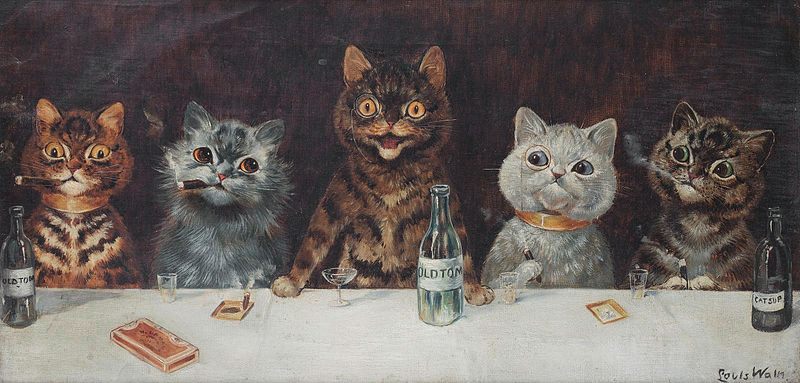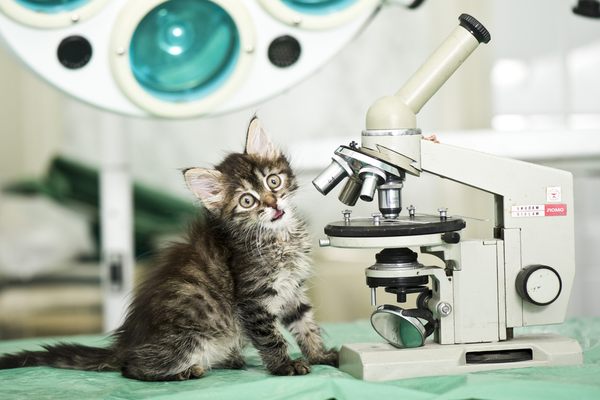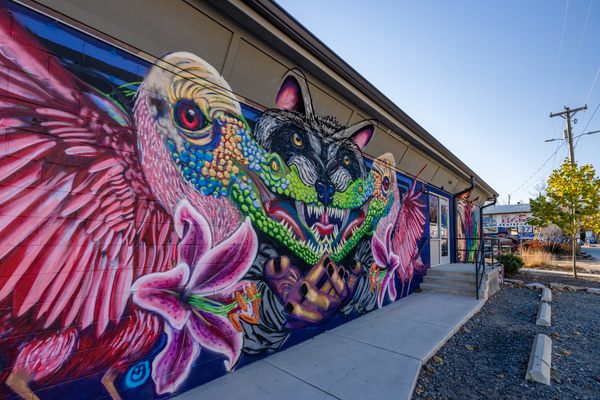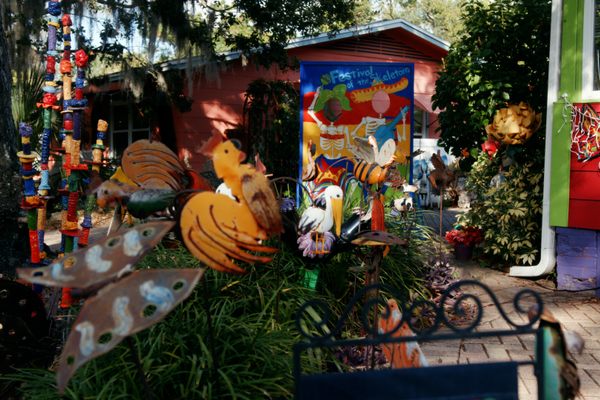Before Cat Memes, There Were Louis Wain’s Controversial Cat Illustrations

Three cats singing, by Louis Wain. (Photo: Wellcome Images, London/CC BY 4.0)
Even before Toxoplasma gondii, cat people have been thought to be a little bit crazy. And just as today’s cat lovers flood the internet with anthromorphized felines, Victorian-era Englanders also found representations of the pets to obsess over—namely, the cats drawn by prolific illustrator Louis Wain, whose cartoonish animals populated the era’s magazines, children’s books, and postcards.
During Wain’s life, though, his fortunes reversed several times. Believed to be suffering from schizophrenia, Wain lived his final years in institutions. Eight of his cat drawings—which range from cuddly to psychedelic—came to be known as the “Famous Series” and for years would be offered up as a the stages of a deteriorating mind, illustrated.

But the truth is a bit more complicated.
Born in London in 1860, Wain attended the West London School of Art and, after a brief stint as a teacher, became a freelance illustrator. In 1884 he married Emily Richardson, who succumbed to cancer about three years after their nuptials. The doomed pair owned a black and white cat, Peter, and Wain drew him often. Cats would come to define his career. A frequently reproduced photograph of Wain shows him at his drawing desk. He has a prominent nose and large, neat mustache; one hand is poised over a clean sheet of paper, the other reaches for a fluffy cat perched nearby. Behind him is ornate wallpaper, not dissimilar to patterns that would later show up in his artwork.

Louis Wain at his drawing table, c. 1890. (Photo: Public Domain/WikiCommons)
Wain’s cat drawings began as sober, realistic affairs but his specialty became creatures that walk on hind legs, grin with wide mouths, wear clothes, celebrate Christmas, play golf and drink cocktails. They’re cute, but also sort of sinister; they glare and wink, their tongues loll, they get up to mischief. Wain’s work was hugely popular, as he illustrated hundreds of children’s books, and during a stint in New York City, drew newspaper cartoon strips. Among his celebrity fans were H.G. Wells, the celebrated science fiction author.
“When one is drawing a cat, one’s attention is necessarily fixed more on the paper than the animal, and hence one gets the habit of forming ideas,” a cryptic Wain told the New York Times in 1892.
Wain’s interest in cats wasn’t purely artistic, either. He also served as president of London’s National Cat Club, judging the group’s cat shows.
But by the early 1900s Wain’s health took a turn for the worse. He grew erratic and occasionally violent. In 1924 he was certified insane and committed to the Springfield Mental Hospital in London, and would spend the rest of his life in three different institutions until his death in 1939. Wain made art until he died, and a posthumous showing of his work was organized. Even so, the once popular cat artist faded from the public eye, his death falling the same year Britain entered World War II. This could have been the end of Wain’s story, but it wasn’t. Like a cat in a fable, his artwork had a few lives left, not all of them predictable.
The first reinvention of Wain happened shortly after his death, in 1939, when Dr. Walter Maclay unearthed eight of his works at a junk shop that would come to be known as the “Famous Series”.
The first two are realistic enough, Disney-ish affairs with big round eyes and fluffy faces. The third cat is recognizable too, but ringed in a rainbow of radiating outlines. The next five drawings descend into organized chaos composed of multi-colored shapes and fractals, as if viewed through a kaleidoscope or laid out on a Turkish carpet.
Maclay was a psychiatrist in London with a penchant for art created by patients diagnosed with mental illness. (He also liked to experiment with mescaline, and invited volunteers from the Surrealist art movement to dose up and draw.) Together with his colleague Dr. Eric Guttmann, he assembled the Guttman-Maclay Collection of psychiatric art. (The collection is now overseen by the Bethlem Museum of the Mind, located on the grounds of Bethlem Royal Hospital, where Wain was a patient for several years.) Maclay believed that art was a window into the patient’s mind; he had Wain’s paintings framed and presented them as the illustrated decline of an artist—from cute to crazy.

Wain’s The Bachelor Party. (Photo: Public Domain/WikiCommons)
For decades they were accepted as such and in 1950 they were reproduced in an influential book Psychotic Art. A 1966 New York Times article on schizophrenia featured the paintings with the caption “Progress of a disease—A famous series of paintings by Louis Wain, a London illustrator who succumbed to schizophrenia in middle age, reflect the artist’s mental deterioration.” The images were frequently shown to students as an example of how the mind is changed by mental illness.
The same year the New York Times repeated that widely accepted interpretation of Wain’s images, another chance encounter in an England shop led to a twist in the Wain narrative. Writer Rodney Dale was living in Cambridge with his family where he purchased a Wain illustration at a local gallery. Captivated by it, Dale set out to learn more about the artist, but found little.
“The original thing that struck me was that it was rather curious—because a lot of the work that he did was so good—that he had been so completely forgotten,” says Dale.

Wain’s Kaleidoscope Cats I and II. (Photo: Public Domain/WikiCommons)
He launched an investigation, posting public pleas in newspapers for information about Wain. He combed through hundreds of letters, traveled to visit promising leads, examined a cache of artwork stashed under a bed. His quest culminated in the 1968 publication of Louis Wain: The Man Who Drew Cats. The book stoked new interest in the artist’s work, but it also challenged what had essentially become Wain’s legacy: That the artworks mounted by Maclay depicted an illustrated tour of madness. Dale pointed out that the styles and medium of the eight images varied (one was unsigned, for instance). There seemed to be no evidence of when they were produced, shattering the timeline on which Maclay’s assumptions depended.
“In fact,” said Dale in a talk he gave after the publication of his book, “The only connection between these eight as a series is that they are all by Louis Wain, all the same size and all mounted in one frame.” He went on:
“The fact that they are all the same size is a red herring; most of Louis Wain’s drawings after he was admitted to hospital in 1924 are that size because those who supplied him with artist’s materials bought that size of pad. The fact that they’re all in one frame is Dr. Maclay’s fault.”
Besides mental illness, could there be another explanation for the changing styles? Dale noted that the shifts between representational drawings and interpretative cats could have had another source of inspiration—namely, his family’s textile business. “Louis Wain found joy in wallpaper designs,” said Dale.
More recently, a more expansive view of Wain away from “mental patient” has been gaining currency. In 2012, psychiatrist David O’Flynn gave a gallery talk as part of a Wain exhibition, and declared that the paintings were essentially the work of two men—the artist who created them and the doctor who assembled them and lent them new meaning. But the exact, detailed artworks can hardly be seen as the work of “a man who’s losing his ability to draw or create at all” O’Flynn points out.
Even Wain’s accepted diagnosis of schizophrenia has been reexamined in tandem with his renewed popularity— Wain believes he may have suffered from dementia instead. One researcher suggested in a 2002 paper that the artist had Asperger’s Syndrome. And others have suggested that if his diagnosis of schizophrenia was accurate, his beloved cats could be to blame, since parasites found in cat feces may be connected to the disorder.

Kaleidoscope Cats III and IV. (Photo: Public Domain/WikiCommons)
These days Wain drawings, postcards and books are eBay fixtures and have become treasured collectors items. “Wainery” has found its way onto the auction block, Antiques Roadshow, and countless tattoos. Every summer the Chris Beetles Gallery in London, a preeminent Wain dealer, mounts a Summer Cat Show exhibition of the artist’s work. Perhaps the clearest sign of the illustrator’s enduring popularity is the glut of fakes that have flooded the market. Beetles, proprietor of the eponymous gallery, told the Birmingham Post that he had seen over a thousand Wain forgeries in his time. In 2008, Bonhams had to withdraw two “Futurist Cats” (Wain also made blocky, colorful pottery in the shape of felines) when their authenticity was questioned. Fake Futurist Cats proliferated after a genuine article sold for over $10,000 at auction. Fans now focus on the artist’s unusual style, not the unusual life of the eight paintings Maclay stumbled across at a junk shop.
Not that Wain’s posthumous chroniclers were the only ones who thought cats could tell them something about a man’s mind.

Kaleidoscope Cats VII and VIII. (Photo: Public Domain/WikiCommons)
A cat that has “lived a life of ease, seeing nobody and nothing beyond its mistress, will exhibit the most striking characteristics of its mistress,” Wain wrote in the November 1889 issue of Cassell’s Magazine about what he had learned from judging cat shows. “Another cat will, perhaps, show itself in the highest degree suspicious, taking after its master or mistress again; while a fourth, that has had to fight his way, will quarrel and rush at everything; and a fifth, that has been allowed to roam the country, will ruffle up its straw, get underneath its bed to hide right out of sight, and nothing but force will move it.” If only we could ask Wain’s cats what he was thinking.
Update, 2/22: An earlier version of this story misidentified the war Britain entered in 1939. We regret the error.































Follow us on Twitter to get the latest on the world's hidden wonders.
Like us on Facebook to get the latest on the world's hidden wonders.
Follow us on Twitter Like us on Facebook